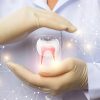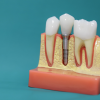Dentistry encompasses a range of specializations and, understandably, it is best that dental implant placements are performed by dental surgeons with the appropriate expertise. The right oral surgeon should also have the ability to manage any potential complications that may arise. Thus, the treatment procedure with dental implants should be carried out by a specialised team, which should consist of a dental surgeon specialised in implants, an Implant Specialist and a Specialised Prosthodontist. Specialisation is usually obtained after three years of postgraduate study.
What should patients know about dental implants? Listed below are 6 key factors.
What are Dental Implants
Dental implants are the ideal alternative to dentures or even dental bridges. As dental bridges often cause problems in the oral cavity and in some cases do not fit properly, dental implants offer immediate and definitive solutions in cases where the lack of natural tooth roots does not allow the placement of fixed prosthetic works. Dental implants replace lost teeth as well as damaged teeth. In place of the lost or damaged teeth, artificial teeth are applied, which in appearance and function are identical to natural teeth. This is achieved by replacing the natural tooth roots with artificial roots made of titanium. Based on this, in many cases they are called screw-in or planted teeth.
Dental implants : About the Procedure
To begin with, it is important to know that the treatment process with dental implants is divided into two parts – phases: The surgical placement phase of the tooth implant and the prosthetic phase, during which the crown is fabricated and placed over the implant. By the term implant we mean only the part of the restoration that is placed inside the jawbone and under the gums. The implant, as mentioned above, replaces the root of the missing tooth. Into it, the dentist screws other components and, of course, the artificial tooth. Upon completion of the treatment process, the restoration piece is placed over the gums and is the artificial “tooth”, the so-called crown. The duration of the surgical procedure is from one to one and a half hours and is performed under local anesthesia. In general, the majority of patients are suitable candidates for dental implants. The chances of success are approximately 98%, however the success of the treatment procedure depends on several factors.
What are the Factors Leading to the Success of the Treatment Procedure with Dental Implants
Smoking and not following the post-operative instructions provided by the dentist are directly linked to increased chances of tooth implant failure. While many patients think that they are not suitable candidates for dental implant restoration, this is generally not the case. For the most part, failed dental implant procedures are due to failure to follow the rules of surgical placement technique, poor quality materials, and improper prosthetic manipulation. The individual patient’s body is not a factor that aggravates and affects the overall chances of success of the treatment procedure. On the contrary, in most cases the healing potential offered by the human body is so helpful that it often covers up any incorrect manipulations made by maxillofacial surgeons who do not possess the necessary experience, knowledge and training. The treatment procedure with the placement of dental implants is now a routine treatment.
Dental Implants: How Much Role Does Choosing the Right Dental Surgeon Play?
To begin with, it is important to mention that there are many ways for a dentist to replace a damaged or missing tooth with a dental implant. The technique used plays a key role in the successful progression of the treatment process. For example, techniques that follow an older philosophy – techniques with prefabricated brackets and bonded restorations – are cheaper and easier for the dentist, but are not as good for the patient. In contrast, screw or screw-retained restoration techniques, where no adhesive is used, are more expensive for the dentist and require much more precision in the placement of the implant, as well as more difficult handling.
However, the absence of glue proves these techniques to be better for the patient. When biocompatibility is significantly reduced, peri-implantitis problems with chronic inflammation and bone loss are more frequent – due to the presence of adhesive. The use of biocompatible materials by the dentist is very important. Metal-free materials, such as dental zirconia, have better and longer term results. Still, screw-retained restorations are easier to remove in order to carry out inspection, maintenance and repair. In contrast, welded restorations are usually destroyed if removed and have to be rebuilt.
Very important at this point is to stress that not everyone has the proper education, training and years of experience to fabricate quality dental implant restorations. The treatment process with dental implants is best undertaken by a specialist team of a Maxillofacial Surgeon, a Specialist Implantologist and a Specialist Prosthodontist.
Nowadays, there are more than 150 companies producing dental implants. The quality of the production materials, the design, the precision of the construction and the application of the implant varies from company to company and at the same time plays a decisive role in order to have a final and excellent result. Also important is the role of the research carried out by each company on the respective topics, as well as the documentation of the biocompatibility of their products and quality control after production. In all of the above, the choice of the company – brand that the dentist makes for the tooth implant plays a dominant role.
About Multiple Dental Implants and Immediate Implant Loading
In case multiple dental implants (at least 4) are to be placed and in good quality hard bone the implants can be loaded immediately and a screw-retained fixed bridge can be constructed within 1-2 days after surgery. However, if the bone is soft, then loading is generally avoided and a mobile temporary solution (chewing gum) follows. The final restoration will be immobile. When large restorations are performed with multiple implants and
Immediate Implant Loading, it is possible that some implants may not be incorporated in the time frame provided. In these cases, it is possible to include more implants in the planning and case planning in order to have enough implants in good dispersion, even if some are not integrated.
Dental Implants: Other Useful Information
Initially, the healing of a dental implant in the jawbone takes an average of 2 months for the lower jaw and 3 months for the upper jaw. However, if the oral surgeon feels that the jawbone at the implant site is relatively soft, then the healing time may take an additional month. Complete immobility during the healing period plays a crucial role in the successful healing and integration of the implant into the bone. Finally, implants require daily maintenance in a similar manner to that performed on other teeth. It requires diligent brushing twice a day for 4 minutes, interdental brushing and super floss for implant-supported bridges. Regular cleanings and checking for possible inflammation of the gums and soft tissues around implants are equally essential for the long-term durability of implants.






